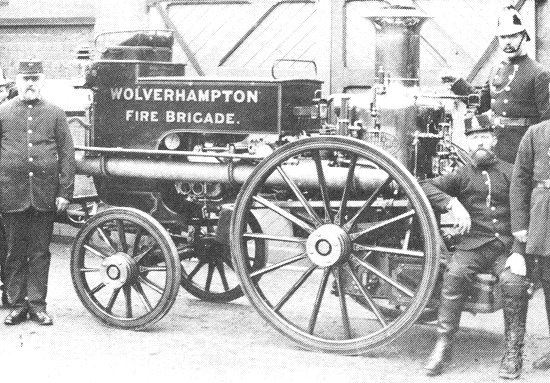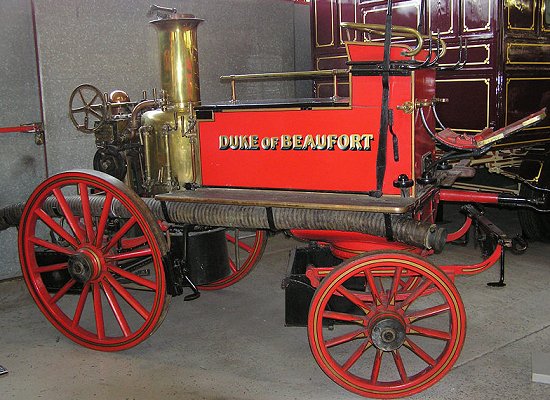|
A Disastrous Fire Things went very wrong in the early
hours of Thursday 22nd May, 1851 when a
severe fire destroyed the original mill building.
Wolverhampton Chronicle commented on the fire as
follows:
The fire “raged with almost
volcanic energy, sending forth huge spires of flame
which overtopped the high shaft of the steam engines,
and were visible for miles.” “…although not of ancient
date, had been erected before iron girders, and other
checks of fire had been introduced. Massy beams of
timber consequently were employed to bear the great
weight of the grain and of the machinery necessary to
grind it; the rooms too, as is usual in such buildings,
were low, and thus the joists and flooring being, as
might be expected, very dry, an unfortunate facility was
presented to feed and to communicate ignition, when it
once commenced”.
The building was completely destroyed
except for the outer walls, which had to be shored up
to prevent collapse. The two steam engines and boilers
were only slightly damaged, so presumably they were in a
separate building. The house, several store rooms, and
the sack warehouse, were saved.
It appears that the fire which
started on the 4th floor was first spotted by a boatman
who ran up the road to the night watchman shouting
“Fire”. The watchman saw the flames coming from near the
brusher, ran to get some water, but then found that he
could not get near the source of the fire because of
flames and smoke. It is believed that the fire had been
caused by friction in the machinery. |

A Wolverhampton-based fire engine from around
1900.
|
Four fire engines were called from
Wolverhampton, but there was little that they could do.
They were assisted by local police, and a detachment of
the 50th Foot, consisting of 60 men under the
command of Captain Bellars and Lieutenant Galton. The
situation was made worse because the mill was fitted
with gas lighting, and when the gas pipes melted due to
heat from the fire, the gas fed the flames. Around two
hours after the start of the fire, the road was
dug up and the gas main severed, but the fire was not
fully extinguished until Friday afternoon.
At about half past ten on Thursday
morning the fire still raged, a large amount of grain
and flour continued to burn fiercely. It was feared that
the outer walls would disintegrate, due to the great
weight that was leaning against them from the floors
that had collapsed. Any falling masonry could have
resulted in fatalities amongst the people fighting the
fire. In order to quickly get the fire under control, extra fire engines were called from
Birmingham.
At the time the mill contained
12,000 bags of grain, most of which were
ruined, and carried away in canal boats for disposal. The loss was estimated at between
£10,000 and £20,000, only £8,000 of which was covered by
insurance. The remaining sum had to be found by the
Norton family. The fire had been the largest in the town
for many years. Even though a number of fire engines attended
the blaze, little could be done because of a shortage of
hosepipe, and a lack of power from the engines, which
could not direct the water onto the top of the building.
|

A fire engine from 1906. Courtesy of
Arpingstone on Wikipedia.
|
The Birmingham Journal reported the
event on the 24th May as follows:
“Without wishing to impute blame in
any quarter, we are only reiterating the almost
universally expressed opinion that the existing
arrangements of the town are utterly inadequate to meet
calamities like the present. The fire engines are not
sufficiently numerous or powerful, nor in that
efficiency which a town like Wolverhampton requires.
However, the present occurrence will doubtless force the
subject upon the public authorities”.
"The origin
of the fire is involved in doubt, and probably will
remain so; but an opinion has been expressed that the
great friction of the spindles of some of the brushes
caused the adjacent woodwork to ignite. We understand
that the evidence of the men who were at work until
twelve o'clock at night, has been taken, but nothing
satisfactory could be ascertained as to the origin of
the fire, although from the rapidity with which the
flames spread, it would seem to lead to the inference
that the fire must have arisen from the friction caused
by the working of 'the brusher', which, it appears, is
used for the purpose of cleaning the wheat after it is
received from the farmers, and before grinding."
During the following month the
Wolverhampton Watch Committee reported that
“In
consequence of the recent disastrous fire at Norton’s
Mill, they recommend that a separate fire brigade be
formed.” In reality it took two years to form the
Wolverhampton Fire Brigade.
|
 |
|
 |
|
 |
Return to
The Early Years |
|
Return to
the beginning |
|
Proceed to
A Fireproof Mill |
|